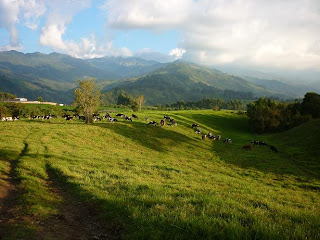Being a lover of salsa dancing I went to Calí in the hope that I could become totally immersed. I arrived in time for the last 3 days of the International Salsa Festival, which in reality featured mostly performers from Calí, although a few other cities seemed to have a bit of a look in. In the true tradition of political rallies, good audience attendance was guaranteed by giving out tickets for free, so the TV cameras could pan over a packed plaza de los toros. All the barrios seemed to have several schools of salsa, each of which put forward a dance team, and which were cheered loudly by the relevant sectioins of the audience. Calí salsa seems to consist of ultra fast foot work and acrobatic moves which are quite breathtakingly risky, but after seeing it for 4 hours I stopped being dazzled. For me, in the end the best couple was that from Brazil, who were invited to display and weren't even in the competition. They seemed to have it all, a flow, sensuality and of course the physical pyrotechnics. It was all the more fun having been to one of their workshops. There was a US couple who did a beautiful contemporary dance routine, but more with an eastern mystic feel, with unbelievable lifts, so the slight woman appeared like a bird on a strong tree, and even more amazing when she supported all her partner's weight. The British team were camp and embarrassing. They just didn't seem to have the musicality nor the connection with each other. However, none of these was competing.
So in the end, I saw a lot, but didn't dance too much myself, which was a bit of a shame. Partly it was shyness, and partly things seemed to start very late, and as I can't sleep late it was simply too exhausting. I did have some fun with it, but the best evening was when I went out with some people from the same hostel. They seemed to be able to have more fun, whereas the locals seemed to need to drink a lot. And yes, it was very easy to meet women who wanted to go out with me, but in the end what was a fun flirtation and opportunity to practise Spanish became a drag, as there was little in common apart from my ability to pick up the tab. Anna is a nurse and a good woman, but in the end there was nothing to talk about, and she wasn't very patient when she danced with me. They have been dancing a particular way from the word go, so if it doesn't fit, it doesn't work. As I have to consciously work at my dancing and I dance a different style (Cuban) with a different lead it was difficult for me to not lapse back into that habit.
I liked the energy and warmth of Calí, and I could easily have spent far more time there, finding a school and dancing every day for a few months. Then I'm sure it would have gelled.
 |
| Posing with a exquisite Brazilian dancer after the workshop she and her dance partner taught |
 |
| La Ermita Iglesia seen looking down Avenida Colombia |
 |
| Publicity for a particuarly stimulating concert |
 |
| The pedestrian walkway across Av Colombia |
 |
| Teresa, purveyor of fine fruit juices |
 |
| A young performer poses with her family at the "International" Festival of Salsa |
 |
| Amazing poise for someone so young |
Anna who came to the final of the Festival with me


















































